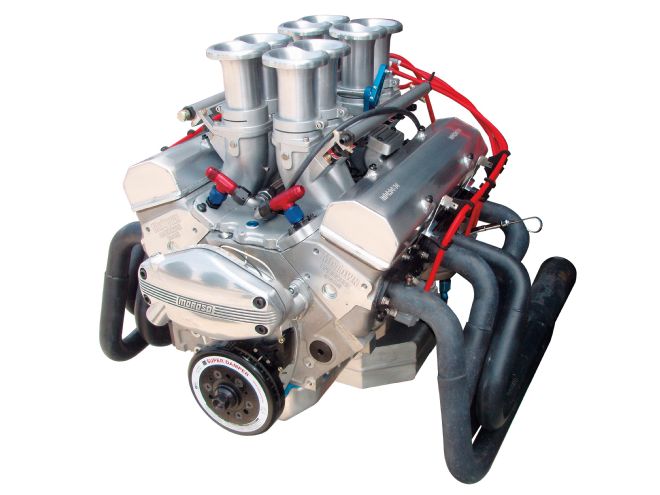
Engine builders generally operate on fairly straightforward parameters. For the NHRA/IHRA class racer the objective is to achieve maximum performance within the rules. Likewise, contestants in the AMSOIL Engine Masters Challenge must adhere to certain restrictions. For "Super" class and E.T. Bracket racers the goal is to build a consistent, reliable engine. But when Bill Holland sought to develop a powerplant for his unique 1923 "Track-T" street rod (which was featured in the September '10 issue of Hot Rod magazine) there were a multitude of factors to contend with.
The car itself is a blend of classic styling and contemporary technology, with a major emphasis on performance. It's a T-bucket engineered to stomp a Z06 Corvette on the dragstrip and road course. Bill's idea was to use a venerable small-block Chevy engine that looked and acted like it came out of a Sprint Car-but it would need to be well mannered for cruising and not require constant maintenance. Additionally, weight was a consideration. And lastly, Bill wanted the engine to shine in the 2,500 to 6,500-rpm range as put forth in the EMC, as that's where it would be spending most of its time.
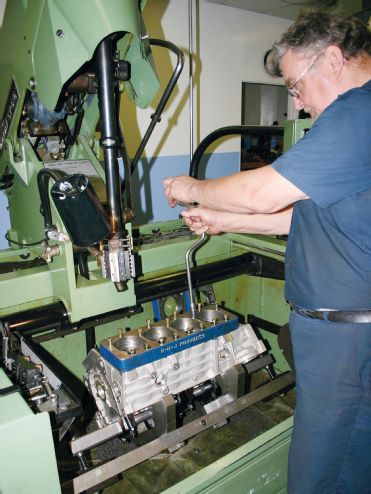 When it comes time to put high-end parts under the machines, you definitely need to have complete trust in the machinist. With Ollie Hellert manning the tools, there was no doubt about a job done right. Here the Motown Lite aluminum block was being prepared for torque plate honing.
When it comes time to put high-end parts under the machines, you definitely need to have complete trust in the machinist. With Ollie Hellert manning the tools, there was no doubt about a job done right. Here the Motown Lite aluminum block was being prepared for torque plate honing.
From an aesthetic standpoint the obvious link to Sprint Cars was a set of Kinsler port injectors. There's something about a set of eight flared stacks that appeals to most hot rodders. The trick was to combine panache with performance. And the key to the equation was a FAST controller, which allowed the fuel and ignition curves to be optimized throughout the engine's very broad powerband. A set of blueprinted fuel injectors from RC Engineering also contributed to the engine's smooth operation, while XRP's braided stainless steel hoses and black anodized AN fittings added a finishing touch to the fuel system.
Let's go from the bottom up. Given the criteria for keeping weight to a minimum, a World Products Motown Lite aluminum block was selected. Weighing about 100 pounds with sleeves, it fits the bill for lightness. Other important features of the World block include "bulges" for larger water passages and horizontal ribs that offer benefits in both cooling and cylinder bore stability. They look sweet, too. The block comes with billet steel four-bolt splayed mains and ARP hardware, and there are reinforcing ribs in the valley connecting the banks. They are drilled to cross-feed the lifter galleys. Optimum lubrication is assured through the use of a priority main oil system, which feeds the crankshaft bearings first and the valvetrain last.
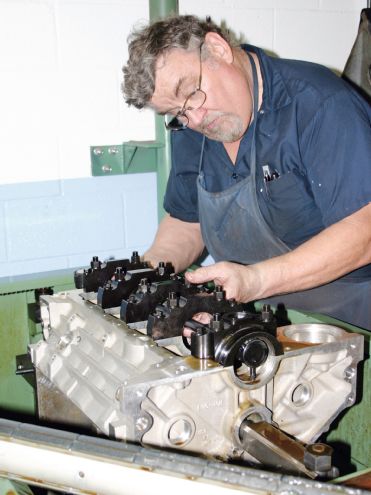 Before engine assembly even begins, a blueprinted assembly means measuring everything, and going through a mock assembly of critical components. Here Ollie checks the main bores with a dial bore gauge.
Before engine assembly even begins, a blueprinted assembly means measuring everything, and going through a mock assembly of critical components. Here Ollie checks the main bores with a dial bore gauge.
Carrying on with the engine's lubrication system, a high-volume Melling OEM-type pump was deemed adequate for the engine's 6,500-rpm ceiling. However, as a precautionary measure the pressure relief valve piston was chamfered and the gear clearance set at .0015 inch. An Aviaid road race pan was selected because the car would be called upon to go around corners aggressively. ARP pan studs and Fel-Pro gasket sealed the deal. With its inboard coilover rocker arm front suspension, similar to an Indycar, triangulated four-bar rear, and wide meats all the way around, skidpad readings nearing 1 g have been achieved. A Pure Power remote oil filter, with a removable stainless steel element that can be easily cleaned, is employed on the car.
The old adage of "there's no substitute for cubic inches" certainly came into play here, with a 4.000-inch stroke Callies 4340 forged steel crank complementing a 4.125-inch bore, for a displacement of 427 ci. Filling the holes are a set of Manley Platinum Series pistons, which are forged from the highly desirable 2618 alloy and weigh about 450 grams. The static compression ratio checked out at 10.5:1 for compatibility with premium pump gas.
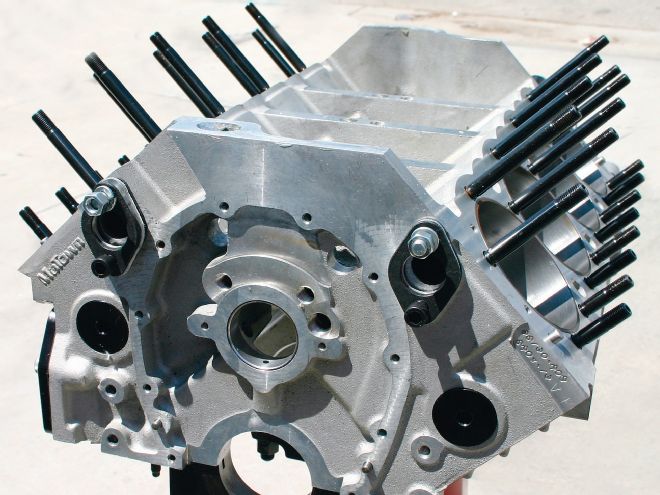 Only once all the checks are made and all of the tolerances are confirmed correct, the block is given a final cleaning and at last assembly can begin. The Motown Lite block was sized to 4.125 inches in the bores.
Only once all the checks are made and all of the tolerances are confirmed correct, the block is given a final cleaning and at last assembly can begin. The Motown Lite block was sized to 4.125 inches in the bores.
Rods are Manley 6.000-inch H-beam, which are forged from 4340 steel and come with ARP rod bolts. Manley also supplied the piston rings, which include a ductile moly top and cast-iron seconds. Clevite H-series rod and main bearings were employed. The rotating assembly was internally balanced by West Valley Balancing and topped off with an ATI SuperDamper.
Selecting the camshaft was obviously an important part of the equation. Given the parameters, Crane Cams' Chase Knight recommended going with a hydraulic roller that was somewhat in the middle of the company's offerings for the small-block Chevy and of a .900-inch base circle configuration to provide necessary clearance for the stroker. Crane PN 119691 was selected, which has 234 degrees duration at .050 (296 degrees advertised) on the intake side and 242 degrees at .050 on the exhaust. Lift is .548-inch intake and .558-inch exhaust, with a lobe separation of 112 degrees. Of course, these are specs with a stock 1.5:1 ratio rocker, but since 1.65:1 ratio shaft-mount rockers were employed the at-the-valve lift is far more aggressive.
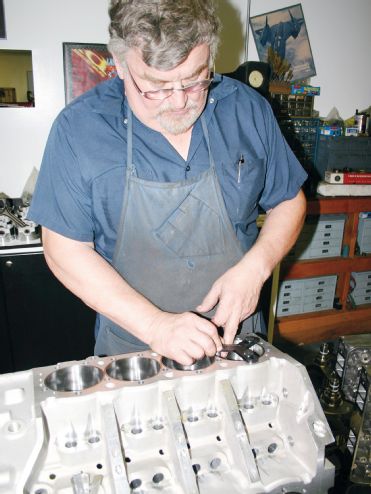 The Manley rings were checked in the bore and gapped to .018/.018 inch. It is important to assign each ring to its specific position once fitted to a bore.
The Manley rings were checked in the bore and gapped to .018/.018 inch. It is important to assign each ring to its specific position once fitted to a bore.
Crane's shaft-mount rockers are in themselves quite interesting as they utilize a Poly-Matrix composite bearing instead of the conventional needle bearings. This is said to improve the efficiency of the system since there is no parasitic loss as the needles reverse direction with every cycle. The composite bearings are also thinner than needle bearings, which allow the shaft diameter to be increased for additional stability. The rocker arm bodies also feature what Crane calls "Quick-Lift" technology. This is simply the result of moving the pushrod seat inward and down as compared to other designs, which affects the geometry to the point where the valve comes off the seat at a higher ratio (around 1.72:1) and returns to 1.65:1 at mid lift. Naturally, the pushrod length was optimized and one-piece chrome-moly units employed.
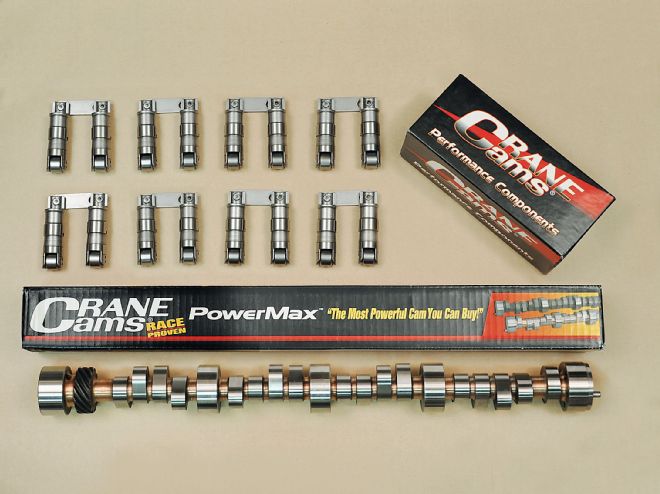 The Crane hydraulic roller cam is a key component in getting the desired results from the engine. The hydraulic roller offers durable and trouble-free operation, while the moderate specifications of 234/242 degrees duration at .050 inch and the 112-degree lobe separation provide a streetable grind.
The Crane hydraulic roller cam is a key component in getting the desired results from the engine. The hydraulic roller offers durable and trouble-free operation, while the moderate specifications of 234/242 degrees duration at .050 inch and the 112-degree lobe separation provide a streetable grind.
World Products' tried-and-true 220cc intake Motown Lite aluminum cylinder heads were used at the time of the build, although the firm's new 235cc 23-degree heads would have made an interesting alternative. It also would have eliminated the need to enlarge the pushrod passages to accommodate the geometry of the shaft rockers. A set of ARP chrome-moly head studs assured the required clamping force.
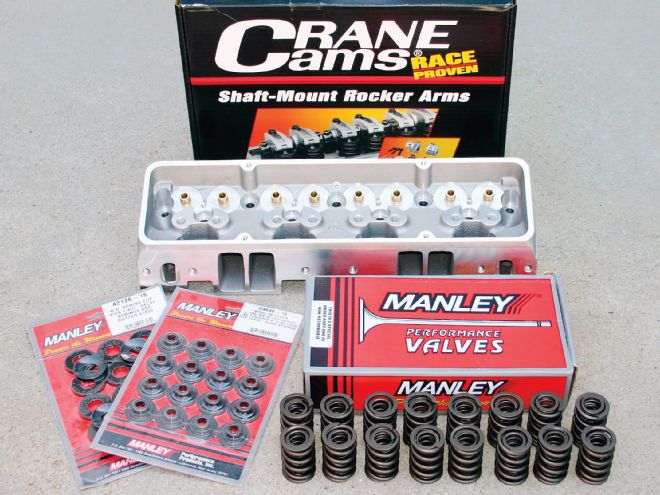 The cylinder heads are World's 220cc Motown Lite units, and these too were filled with premium components, including 2.08-/1.60-inch Manley severe-duty valves, NexTek valvesprings, topped with Crane shaft-mounted 1.65:1 ratio composite-bushed rocker arms.
The cylinder heads are World's 220cc Motown Lite units, and these too were filled with premium components, including 2.08-/1.60-inch Manley severe-duty valves, NexTek valvesprings, topped with Crane shaft-mounted 1.65:1 ratio composite-bushed rocker arms.
Manley 2.080-inch diameter severe-duty stainless steel intake valves were used, as were 1.600-inch diameter severe-duty exhaust valves. Titanium retainers were employed to harness the Manley NexTek valvesprings. Capping the valvetrain are Moroso fabricated aluminum valve covers, with a Moroso electric water pump handling the cooling.
An MSD billet distributor with a built-in reluctor wheel called the shots to the ECU, while a familiar 6 AL ignition, coil, and 8.5mm spark plug wire delivered the energy to the plugs. In the vehicle a Powermaster alternator replenishes the car's Optima battery, while a Powermaster starter handles the cranking.
Ollie Hellert of Van Nuys, California, performed the machine work on the engine (align bore, plate hone, decking) and cylinder heads. Ollie and car owner Bill assembled the unique small-block. Tom Habrzyk, known for his many fuel injection related article in the pages of Engine Masters, lent his expertise to the project, first mapping the FAST controller for pulls on the dyno, and later dialing it in on his chassis dyno (EFI West) when the engine was installed in the roadster.
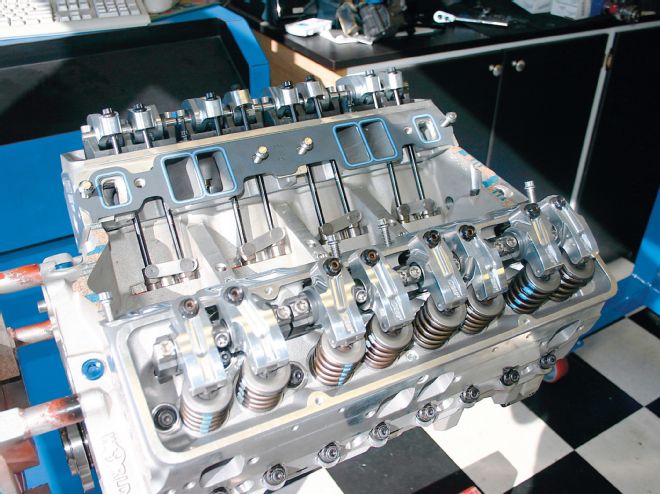 Here the build progressed to the completion of the top end. The critical operation here is to check all of the valvetrain components for clearance throughout their travel. Note the very beefy ribbed valley structure of the World aluminum block.
Here the build progressed to the completion of the top end. The critical operation here is to check all of the valvetrain components for clearance throughout their travel. Note the very beefy ribbed valley structure of the World aluminum block.
On the SuperFlow 902 dynamometer the engine pumped out 567 hp at 6,300 rpm, while the near-flat torque curve peaked at 563 lb-ft at 4,800 rpm. The engine is very docile and mild mannered at low rpm, but when the pedal is to the metal it's no holds barred!